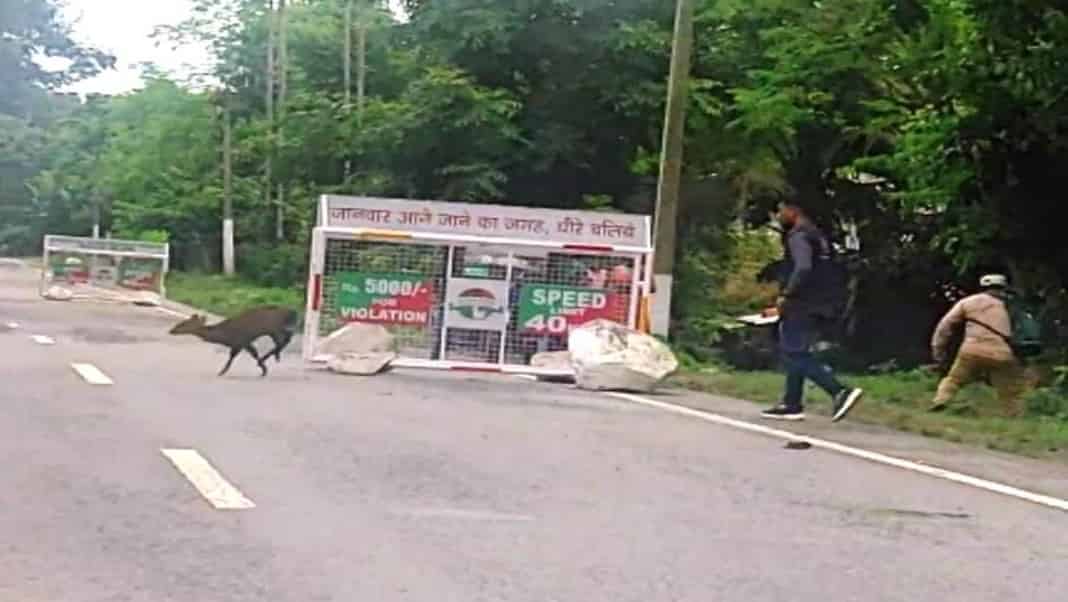77 wild animals dead, 94 others rescued in Kaziranga
Guwahati, July 5: The improvement in the flood situation in Kaziranga National Park has prompted the authorities to relax the movement of vehicular traffic starting Friday. Despite this, more than 50 per cent of the park area remains submerged underwater, continuing to pose significant challenges for wildlife and conservation efforts.
In a partial modification of the order issued on June 30, the Golaghat Superintendent of Police has relaxed vehicular traffic restrictions on National Highway 37 (NH 37) while implementing speed controls to minimize the risk of accidents and ensure the safety of animals crossing the highway in search of higher ground.
According to the revised order, the entry of commercial trucks are allowed from Numaligarh Tiniali from 7 am to 3 pm while the entry of commercial trucks from Panbari, Bokakhat and Bagori Border will be from 8 am to 4 om in regulated speed under piloting by police and forest staff.
Commercial trucks are not allowed to enter Kaziranga National Park from 4 pm to 8 am.
The movement of passenger vehicles (both private and commercial) at the regulated speed under piloting by police and forest staff will continue round the clock every half an hour.

The flooding in Kaziranga National Park and Tiger Reserve (KNPTR) has resulted in the loss of 77 animals due to drowning, while 94 animals have been rescued from the floodwaters.
This UNESCO World Heritage Site is known for its rich biodiversity, including endangered species like the Indian rhinoceros and Bengal tiger.
The flooding has impacted Pobitora Wildlife Sanctuary, submerging 60% of its area. There have been no reports of animal deaths in the sanctuary so far.
The animal mortality includes 23 hog deer that drowned and 7 others that died during treatment.
Apart from a rhino calf, a significant number of animals have been rescued, including 73 hog deer, one Indian hare, 2 otter pups, 2 sambar deer, one jungle cat, and two scops owls.
Currently, 20 animals are undergoing treatment, which indicates ongoing efforts to ensure their recovery and well-being. Additionally, 31 animals have already been treated and released back into their natural habitat.

The flooding has significantly impacted the camps under the Eastern Assam Wildlife Division. Currently, out of the total 233 camps, 67 are still inundated, down from 173 reported on Wednesday.
Additionally, seven camps have been vacated due to the flooding: 2 in Kaziranga range, 3 in Bokakhat range, and one each in Biswanath Wildlife Division and Nagaon Wildlife Division.
The authorities have taken proactive measures to protect wildlife during this period of flooding in Kaziranga National Park.
Intensifying security arrangements in and around the national park further underscores the commitment to safeguarding wildlife during this challenging time.
Despite the receding water levels of the Brahmaputra River, water within the park itself has not yet started to recede. This ongoing inundation continues to pose significant challenges for wildlife and conservation efforts in Kaziranga National Park. Authorities and conservationists are closely monitoring the situation to ensure the safety and well-being of the park’s diverse wildlife during this period.

Kaziranga National Park director Sonali Ghosh underscored the active measures being taken in response to the flooding in Kaziranga National Park. To ensure the safety of wildlife, staff from seven camps have been relocated to other camps, and there is cooperation from the public in these efforts, she said.
Additionally, the flood situation in Pobitora Wildlife Sanctuary in Morigaon district is also improving even as 40 per cent area of the sanctuary is still under water.
Out of 22 forest camps, 11 are still under water, a forest official said.
The flood has caused significant damage to Pobitora Wildlife Sanctuary, which is renowned for being the world’s densest habitat of one-horned rhinos.
Approximately 50% of the sanctuary’s infrastructure has been damaged as a result of the flooding. Several link roads connecting the sanctuary have also been submerged, with some washed away completely in certain areas, according to forest officials.
Also Watch
Find latest news from every corner of Northeast India at hubnetwork.in, your online source for breaking news, video coverage.
Also, Follow us on-
Twitter-twitter.com/nemediahub
Youtube channel- www.youtube.com/@NortheastMediaHub2020
Instagram- www.instagram.com/ne_media_hub





